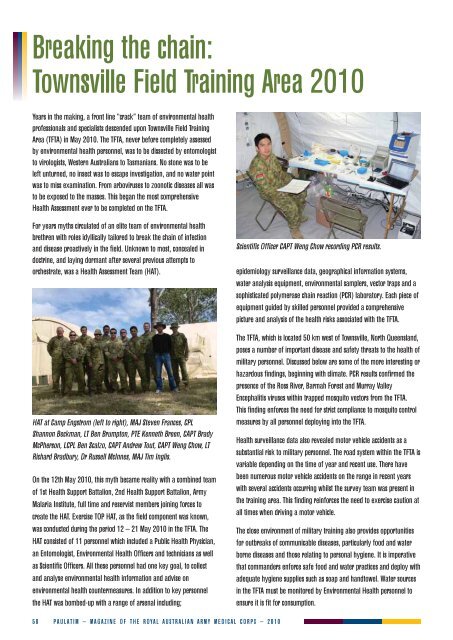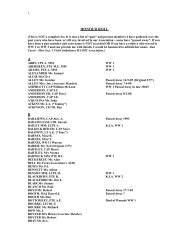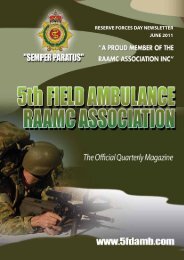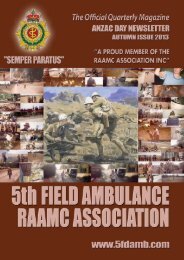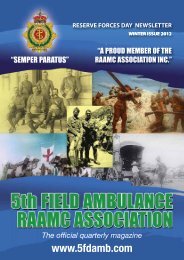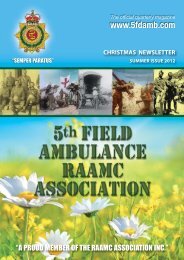2010 Paulatim Magazine - RAAMC Association
2010 Paulatim Magazine - RAAMC Association
2010 Paulatim Magazine - RAAMC Association
You also want an ePaper? Increase the reach of your titles
YUMPU automatically turns print PDFs into web optimized ePapers that Google loves.
Breaking the chain:<br />
Townsville Field Training Area <strong>2010</strong><br />
Years in the making, a front line “crack” team of environmental health<br />
professionals and specialists descended upon Townsville Field Training<br />
Area (TFTA) in May <strong>2010</strong>. The TFTA, never before completely assessed<br />
by environmental health personnel, was to be dissected by entomologist<br />
to virologists, Western Australians to Tasmanians. No stone was to be<br />
left unturned, no insect was to escape investigation, and no water point<br />
was to miss examination. From arboviruses to zoonotic diseases all was<br />
to be exposed to the masses. This began the most comprehensive<br />
Health Assessment ever to be completed on the TFTA.<br />
For years myths circulated of an elite team of environmental health<br />
brethren with roles idyllically tailored to break the chain of infection<br />
and disease proactively in the field. Unknown to most, concealed in<br />
doctrine, and laying dormant after several previous attempts to<br />
orchestrate, was a Health Assessment Team (HAT).<br />
HAT at Camp Engstrom (left to right), MAJ Steven Frances, CPL<br />
Shannon Beckman, LT Ben Brumpton, PTE Kenneth Breen, CAPT Brady<br />
McPherson, LCPL Ben Scalzo, CAPT Andrew Tout, CAPT Weng Chow, LT<br />
Richard Bradbury, Dr Russell McInnes, MAJ Tim Inglis.<br />
On the 12th May <strong>2010</strong>, this myth became reality with a combined team<br />
of 1st Health Support Battalion, 2nd Health Support Battalion, Army<br />
Malaria Institute, full time and reservist members joining forces to<br />
create the HAT. Exercise TOP HAT, as the field component was known,<br />
was conducted during the period 12 – 21 May <strong>2010</strong> in the TFTA. The<br />
HAT consisted of 11 personnel which included a Public Health Physician,<br />
an Entomologist, Environmental Health Officers and technicians as well<br />
as Scientific Officers. All these personnel had one key goal, to collect<br />
and analyse environmental health information and advise on<br />
environmental health countermeasures. In addition to key personnel<br />
the HAT was bombed-up with a range of arsenal including;<br />
Scientific Officer CAPT Weng Chow recording PCR results.<br />
epidemiology surveillance data, geographical information systems,<br />
water analysis equipment, environmental samplers, vector traps and a<br />
sophisticated polymerase chain reaction (PCR) laboratory. Each piece of<br />
equipment guided by skilled personnel provided a comprehensive<br />
picture and analysis of the health risks associated with the TFTA.<br />
The TFTA, which is located 50 km west of Townsville, North Queensland,<br />
poses a number of important disease and safety threats to the health of<br />
military personnel. Discussed below are some of the more interesting or<br />
hazardous findings, beginning with climate. PCR results confirmed the<br />
presence of the Ross River, Barmah Forest and Murray Valley<br />
Encephalitis viruses within trapped mosquito vectors from the TFTA.<br />
This finding enforces the need for strict compliance to mosquito control<br />
measures by all personnel deploying into the TFTA.<br />
Health surveillance data also revealed motor vehicle accidents as a<br />
substantial risk to military personnel. The road system within the TFTA is<br />
variable depending on the time of year and recent use. There have<br />
been numerous motor vehicle accidents on the range in recent years<br />
with several accidents occurring whilst the survey team was present in<br />
the training area. This finding reinforces the need to exercise caution at<br />
all times when driving a motor vehicle.<br />
The close environment of military training also provides opportunities<br />
for outbreaks of communicable diseases, particularly food and water<br />
borne diseases and those relating to personal hygiene. It is imperative<br />
that commanders enforce safe food and water practices and deploy with<br />
adequate hygiene supplies such as soap and handtowel. Water sources<br />
in the TFTA must be monitored by Environmental Health personnel to<br />
ensure it is fit for consumption.<br />
5 0 P A U L AT I M – M A GAZINE O F T HE R OYA L A U S T R A L I A N A R M Y M E DICAL C O R P S – 2 0 1 0


